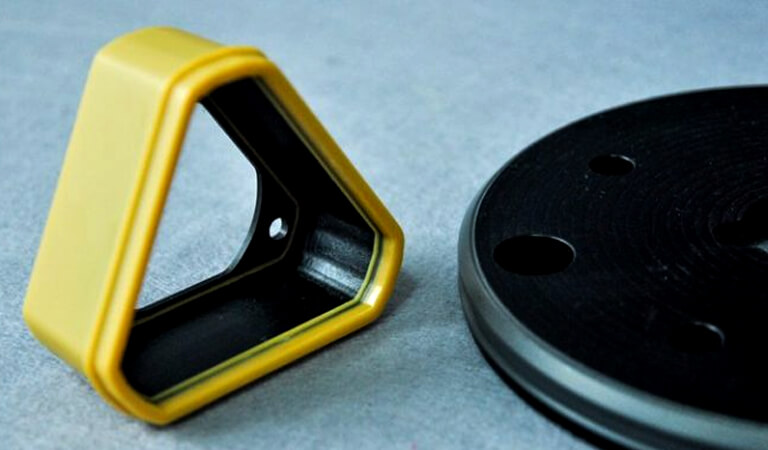ABS usually refers to acrylonitrile butadiene styrene copolymer, which is made by copolymerizing three monomers: acrylonitrile, butadiene and styrene. Due to the different proportions of monomers, ABS has different properties and melting temperatures. After blending with other plastics or additives, the uses and properties of ABS can be further expanded, such as impact-resistant grade, heat-resistant grade, flame-retardant grade, transparent grade, reinforcing grade and plating grade.
The fluidity of ABS is between polystyrene (PS) and polycarbonate (PC), and its fluidity is affected by injection temperature and pressure. Among them, the injection pressure has a slightly greater effect, so in the molding process usually use a higher injection pressure to reduce the melt viscosity and improve the mold filling performance.
- Handling of plastic
The water absorption of ABS is about 0.2%-0.8%. For general grade ABS, it should be dried in an oven at 80-85°C for 2-4 hours or in a dry hopper at 80°C for 1-2 hours before processing. For heat-resistant grade ABS containing polycarbonate components, the drying temperature should be increased to 100°C as appropriate. The proportion of recycled material should not exceed 30%, and electroplating grade ABS should not use recycled material.
- Selection of injection molding machine
You can choose the standard injection molding machine of Huameida (screw L/D ratio is 20:1, compression ratio is more than 2, injection pressure is more than 1500bar). If you need to use color masterbatches or products with high appearance requirements, you can choose a first-class injection molding machine with a smaller screw diameter. Clamping force should be determined between 4700-6200t/m2 according to the plastic grade and product requirements.
- Mold and gate design
The mold temperature is set at 60-65℃. The runner diameter is 6-8mm, the gate width is about 3mm, the thickness is the same as the product, and the gate length should be less than 1mm. the vent width is 4-6mm, and the thickness is 0.025-0.05mm.

- Melt temperature
It can be accurately determined by using the air-to-air injection method. Different grades of ABS corresponding to different melt temperatures are suggested as follows:
– Impact resistant grade: 220°C-260°C, optimum temperature is 250°C.
– Electroplating grade: 250℃-275℃, optimal temperature is 270℃.
– Heat-resistant grade: 240℃-280℃, the best temperature is 265℃-270℃.
– Flame retardant grade: 200℃-240℃, the best temperature is 220℃-230℃.
– Transparent grade: 230℃-260℃, the best temperature is 245℃.
– Glass fiber reinforced grade: 230°C-270°C
For products with higher surface requirements, higher melt and mold temperatures should be used.
- Injection speed
A slower speed should be used for fire-resistant grade products and a faster speed should be used for heat-resistant grade products. If the product has high surface requirements, high speed and multi-stage injection speed control should be used.
- Back pressure
In general, the lower the back pressure, the better, commonly used back pressure is 5 bar, dyeing materials need a higher back pressure to ensure uniformity of color mixing.
- Retention time
At a temperature of 265°C, the retention time of ABS in the melt cylinder should not exceed 5-6 minutes at the most. For flame retardant grades the time is even shorter. If a shutdown is required, the set temperature should be lowered to 100°C and then the melt barrel should be cleaned out using general purpose grade ABS. The cleaned mix should be placed in cold water to prevent further decomposition. If it is necessary to switch from other plastics to ABS, the melt barrel should be cleaned with PS, PMMA or PE first. Some ABS products may be fine when they are first demolded, but after a while they may show discoloration, which may be caused by overheating or staying in the melt cylinder for too long.
- Post-treatment of products
Generally ABS products do not require post-processing, only plating grade products need to be baked (70-80°C, 2-4 hours) to passivate the surface and no mold release agents should be used. The products should be packed immediately after removal.
- Matters requiring special attention during molding
Certain grades of ABS (especially flame retardant grades) have a strong adhesion of the melt to the surface of the screw after plasticizing, which may cause the surface of the screw to decompose over time. When the above situation occurs, it is necessary to pull out and wipe the screw homogenizing section and compression section, and clean the screw with PS etc. regularly.




Related Posts
Quality Assurance & Quality Control | Definition-Difference-Methods-Process
what is the injection molding-part1
Some tips help you understand electric injection molding machines